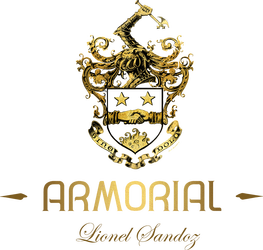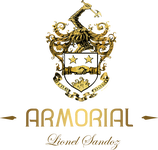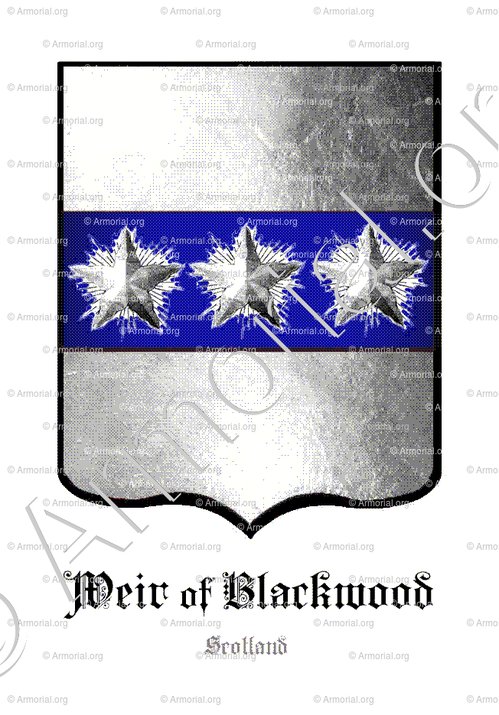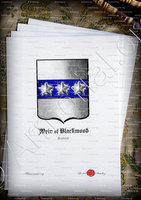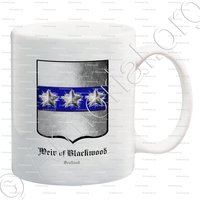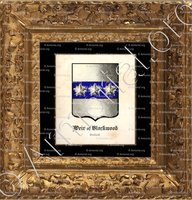DESCRIPTION
WEIR OF BLACKWOOD
Scotland
United Kingdom
- Baronet, November 28, 1694.
- Maintained in status.
Coat of Arms:
"Argent, a fess azure charged with three mullets of the field."
Crest: A horse issuant proper, bridled and caparisoned gules.
Motto: NIHIL VERIUS.
Note:
The lineage of WEIR of BLACKWOOD is a noble Scottish family granted a baronetcy on November 28, 1694. This prestigious title, conferred by the British monarch, highlights the family's importance and contribution to the history and society of Scotland.
Located in Scotland, United Kingdom, the estate of BLACKWOOD stands as a symbol of the WEIR family heritage. Over the centuries, this family has upheld its status and influence despite the political and social changes that have marked the country's history.
BLACKWOOD is today a village bordering Kirkmuirhill, near Lanark in the central belt of Scotland.
The BLACKWOOD estate is now owned by Native Woods Preservation Ltd, dedicated to its conservation. This estate was the largest in the parish of Lesmahagow and by some accounts the largest estate in Lanarkshire.
The baronetcy title is passed down through generations, ensuring the continuity of the family name and heritage. The date of November 28, 1694, marks a pivotal moment in the history of the WEIR family, officially cementing their place in Scottish nobility.
Today, the BLACKWOOD estate remains well-maintained, carefully preserved to reflect the history and grandeur of the WEIR family. This upkeep not only showcases material wealth but also deep respect for traditions and family heritage.
Historical and Biographical Note (1):
The surname WEIR is ancient in Scotland, noted by Sir James Dalrymple in his Collections.
- RUNULPHUS DE WEIR is mentioned in records from Kelso, Paisley, and Murray, living during the reign of King William, and Thomas de WEIR under the reign of Alexander II.
From this surname, several families in Clydesdale descend, the principal ones being BLACKWOOD and Stonebyres.
- Sir GEORGE WEIR of BLACKWOOD bears arms: "Argent, a fess azure charged with three stars of the first, with the Nova Scotia badge in chief on the dexter side, as used by Baronets"; and for Crest, a demi-horse in armor, proper, issuant from a crown of its colors, bridled and saddled gules; and for Motto, Nihil verius. His grandfather was named Lawrie, who married the heiress of WEIR of BLACKWOOD and took the name and arms of WEIR.
Historical and Biographical Note (2):
Lineage
The surname VERE is of great antiquity, written in ancient records as Vere, Veyr, Were, and Weir. The family owned extensive lands in southern Scotland from very ancient times, with their history known to extend over five hundred years.
BALTREDUS DE VERE lived during the reign of King MALCOLM IV, who ascended the throne of Scotland in 1153. He is mentioned as a witness to a charter by King WILLIAM, who succeeded MALCOLM in 1165. Baltredus had two sons...
MARIOTTE WEIR, heiress of Blackwood, first married Major James Bannatyne, who died shortly thereafter without issue. She then remarried William Lowrie, Esq. of Auchenheath. Following this marriage, he was designated tutor of Blackwood, and they had a son, GEORGE. In accordance with the aforementioned land arrangements, George was named GEORGE WEIR of BLACKWOOD, as specified in a charter of several lands dated August 18, 1668.
There is an act of possession for all lands and the barony of Blackwood, etc., in favor of William Lowrie, Esq., tutor of Blackwood, and Mariotte Weir, his wife, daughter and heiress of the late George WEIR of BLACKWOOD, in liferent, and to George Weir, their legitimate eldest son and heir presumptive, in full property and heritage, dated March 16, 1672. Additionally, there is a resignation by William Lowrie and Mariotte WEIR in favor of the said George WEIR of BLACKWOOD and the male heirs of his body, and failing such heirs, to the eldest female heirs, etc., of all lands of Brown Castle and others in the barony of Blackwood, dated July 10, 1674.
Sources: Genealogical and Heraldic Dictionary of the Landed Gentry of Great Britain and Ireland, 2, 1847.
Blazon:
Argent: The field of the shield is silver (white or light grey).
A fess azure: A horizontal band across the middle of the shield, colored blue.
Charged with three mullets of the field: On this blue band, there are three mullets (stars with straight rays) of the same color as the field (silver).
Symbolic Interpretation of the Coat of Arms:
Argent (Silver): Symbolizes purity, truth, peace, and sincerity.
Azure (Blue): Associated with loyalty, justice, truth, fidelity, and perseverance.
Fess: Often represents a belt or band symbolizing protection and honor. It is also a sign of defense and steadfastness.
Mullets: Stars symbolize aspiration towards the heavens, nobility, guidance, and illumination. They also represent hope and direction.
_______________________________________
SHARE ON SOCIAL NETWORKS
OPINIONS
There are no notes at this time. Be the first to rate!
GIVE A NOTE
